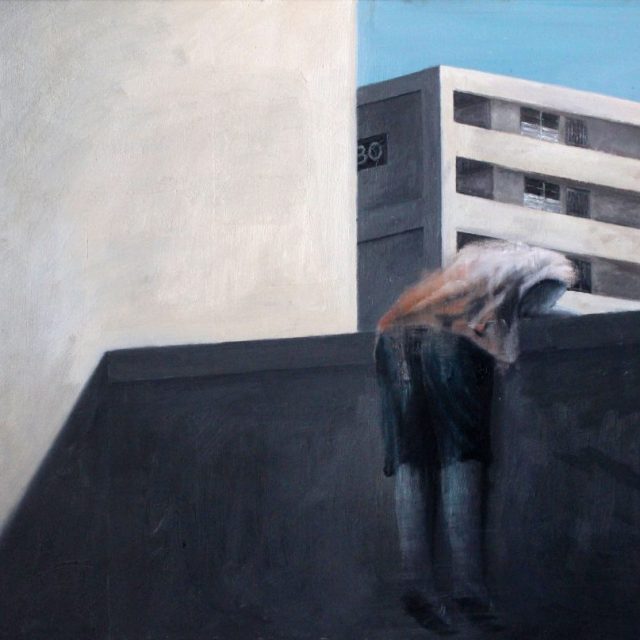Making A Memory | Esmond Loh

Curatorial Statement
Time is said to be boundless, with no beginning or end. Yet, the world bears testimony to the impact of time; wrinkled women scavenging for cardboard in a dustbin, or the middle-aged durian seller with calloused hands. In a fast-paced Singaporean society, some truly live, while others simply exist. Nonetheless, it is not in the most extravagant moments that we seek meaning — sometimes it takes a pensive look into commonplace scenes to understand the complexities that surround our state of being.
States of Being, a solo exhibition by young artist Esmond Loh (b. 1995) and curated by Rachel Poonsiriwong (b. 1997), features a series of paintings that are both a continuation and departure from his previous works. His last series manifested as monochromatic portraits examining the significance of an individual’s existence in an unfathomable void. In States of Being, Loh creates fresh narratives from his past associated with various environments, led by intuition, and smeared by ambiguity. A collective investigation into intricate connections between people, time, and space, the series aims to capture the poignancy of a fleeting moment in time.
While the physical environment is painted precisely, the human figures are painted in a more gestural manner, conveying a sense of movement. Some figures are even rendered to the point of translucency. This together with their black and white skin tones creates the impression that they are ephemeral. It makes one question: Are these people really there? Did they momentarily occupy that space and have since gone? It conveys a fleeting moment; a point of transition where people depart to a different space.
Departure was inspired by a conversation between Loh and a friend that took place four years ago, facing the sea. Subsequent revisits to that place triggered memories of that conversation. The final image was distilled from layers of memories, from having seen and experienced the place again and again. The two people in the painting, while sharing the same bench, appear to be distant, yet close. Based on intuition, Loh changed the colour of the grey stone bench to a robust rust colour, which could be symbolic of the connection between the two. This creates a certain tension between them. It cannot be determined if they are speaking to each other. The sea and clear weather exudes a kind of calmness and stillness, all the more making the scene appear contemplative.
Incident receives much speculation; a classic lean over the parapet could be reminiscent of a suicide attempt scene to some, but the young boy looks almost curious. Balancing precariously on the parapet, the figure creates universal tension, but one also feels intrigued by the hidden truths. What is he looking at? What is the view beneath the parapet? Much like a memory, many will try to dissect an image that is not theirs, to see more of what they cannot see. Loh diffuses the complexities in portraying a memory, choosing to present only stills from moving images. The subsequent mystery is part of one’s viewing experience.
The Hospice is inspired by Loh’s grandmother frequent hospitalisations due to illness. The scene of her suffering (sometimes even on the verge of death) as family members gather around became a recurring memory that evokes many unsettling emotions. This, together with Loh’s preoccupation with the notion of existentialism, makes the painting deeply personal and emotive for him. In The Hospice, the patient is painted in a more controlled and solid way, in contrast to the standing figures that shimmer like ghosts. The immobility of the patient is juxtaposed with the vitality of her family members. One can also view this from the perspective of the patient; the family members appear to come and go or have become unfamiliar. The Hospice also reflects well the sense of alienation that dominates Loh’s work. Despite the presence of a few figures that could be family, they appear reticent and uncommunicative. While Loh started out with no conscious artist references, he later identifies artists whose works have similar visual interests, such as painter Edward Hopper with his iconic, tension-filled quiet scenes. Another could be Nguan, whose brightly lit images evoke introspective feelings not too different from Loh’s darker paintings.
The series is experimental in nature. Loh plays around with various visual devices, one of which is a confusion in personal perspectives. A work that stands out would be Resonance, inspired by his stint as an art teacher in a local secondary school. The particular view of a classroom is vivid in Loh’s memory because it was the view that he often had when observing the lesson from the back of the class. However, the teacher standing at the front was modelled after Loh, as well. So who was he, and who was he looking at?
Taking a dive into Loh’s thought and art-making process, one realises that Loh’s paintings are truly unusual — somewhere between a photograph, a painting, and a diorama. Loh takes a step back from his usual hyperrealistic style to develop his personal, intuitive flair. The series is an introspective, back-to-basics route. Loh offers a series of compelling, disquieting scenes and his unique working method present an unrivalled honesty that challenges the future of painting in Singapore.
You can catch States of Being at Chan Hampe Galleries, 328 North Bridge Road, #01-21 Raffles Hotel Arcade, Singapore 188719 until 30 April.
 Singart
Singart
